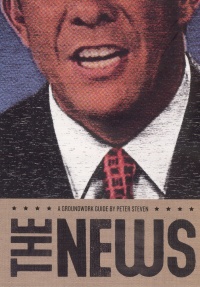| ________________
CM . . . . Volume XVI Number 41. . . .June 25, 2010. 
 |
The News. (Groundwork Guides).
Peter Steven.
Toronto, ON: Groundwood Books/House of Anansi Press, 2010.
144 pp., pbk. & hc., $11.00 (pbk.), $18.95 (hc.).
ISBN 978-0-88899-823-1 (pbk.), ISBN 978-0-88899-822-4 (hc.).
Subject Headings:
Press-Influence.
Reporters and reporting.
Freedom of the press.
Prejudices in the press.
Press monopolies.
Press-Asia.
Grades 9-12 / Ages 14-17.
Review by Val Ken Lem.
***/4
|
| |
|

excerpt:
Media coverage can shape foreign policy as well. Government leaders often assume that, if the news media has taken no interest, the public doesn’t care either. American media scholar Philip Seib suggests that, in situations where an argument might be made for international intervention to stop a country engaged in human-rights abuses, the role of the press becomes particularly crucial. He argues that, for Somalia, Rwanda, Sierra Leone, East Timor and Bosnia, in the 1990s, better media coverage of impending disasters might have prompted a more timely and humane response from the world’s powerful countries. The same holds for the Iran-Iraq war of the 1980s, a conflict of which the Western media took little notice. How different the world situation might be today if we had learned during those years that the US was actively supporting Saddam Hussein’s Iraq.
Peter Steven, a post-secondary teacher of media studies with a PhD in Radio/TV/Film, is well qualified to write The News. His writing style straddles the formal/informal divide, but his use of endnotes and identification of sources in the body of the text, as illustrated in the excerpt, gives The News added value as a scholarly work. This volume in the “Groundwork Guides” series deserves a wide readership. It is an informative, critical, potentially controversial analysis of journalism and mass media that goes beyond the North American scene to introduce the reader to comparable and different trends evolving in other parts of the world. Even media savvy adult readers will gain new insights into the news business.
A list of chapter titles indicates the broad scope of the work: News is power, Anatomy of the news, The dominant media, Print, radio and television, The Internet, Ethics, Investigative journalism, War and international news. The cataloguer who created the subject headings reported in the CIP data and recorded at the head of this review deserves a salute for accurately expressing many aspects of this work.
Steven focuses upon professional journalism and emphasizes the ideals of neutrality, objectivity and unbiased reporting, the provision of facts without opinion, and efforts to report the truth. Using a definition of the news as being concerned with “the present tense, big consequences, sudden change, and the story,” he is most concerned with hard news and gives only passing mention to lifestyle, entertainment and sports reporting. He suggests that superficial stories and stories about fashion, autos, technology, real estate and lifestyles are really non-news ads masquerading as stories. He observes that “[t]hey’re basically product promotions with photos supplied by the seller and with text only slightly rewritten from press releases.” There is even a word for this kind of journalism: churnalism.
Steven analyses the news in its various formats: print, radio, television, and online (print and video). He highlights features of the various formats and uses examples from around the world. Thus the reader learns that the increase in literacy rates in places like India and China has created a surging demand for printed news sources. In large parts of Africa, the radio remains the predominant source of news. Steven also addresses issues such as convergence and media monopolies, biases, ethics and censorship. He is critical of the censorship and self-censorship that influences the reporting of wars.
The volume includes a four-page News Timeline that extends to pre-classical times, notes, a bibliography and a fairly extensive index. The index includes some useful cross references, like the entry See also Self-censorship under Censorship, but it also lacks entries for many proper names including Asper family, CanWest, Associated Press and Reuters. In fairness, The News includes so many examples and wide-ranging content that it would be a challenge to index every concept and name.
The News is an informative and thought-provoking analysis. The author is clearly a passionate left-of-center advocate for high standards in news in all formats.
Highly Recommended.
Val Ken Lem is the Collections Evaluation and Donations Librarian and subject liaison for History, English and Caribbean Studies and an avid consumer of The News at Ryerson University.

To comment on this title or this review, send mail to
cm@umanitoba.ca.
Copyright © the Manitoba Library Association. Reproduction for personal use is permitted only if this copyright notice is maintained. Any other reproduction is prohibited without permission.
NEXT REVIEW |
TABLE OF CONTENTS FOR THIS ISSUE- June 25, 2010.
AUTHORS |
TITLES |
MEDIA REVIEWS |
PROFILES |
BACK ISSUES |
SEARCH |
CMARCHIVE |
HOME |
